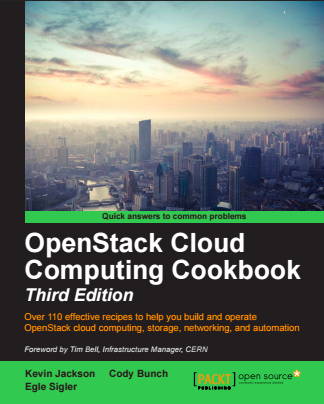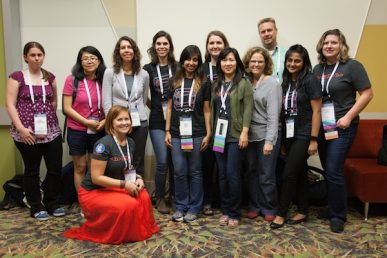Now everyone can get in the kitchen with OpenStack.
To help operators, administrators and anyone working with OpenStack, a trio of Rackspace experts have come together to write the "OpenStack Cloud Computing Cookbook – Third Edition."
The latest edition weighs in at a whopping 436 pages, offering over 110 recipes to help you build and operate OpenStack cloud computing, storage, networking and automation.
Superuser talked to Kevin Jackson, principal engineer, Cody Bunch, principle architect, and Egle Sigler, OpenStack Foundation board member and principle architect, about their book.

Who will this book help?
This book is for OpenStack operators and administrators and those who have been tinkering with OpenStack, who want to know how to get particular tasks done – such as installing OpenStack, creating networks, using cloud-init, and automating their installs using Ansible. – Jackson
Why is a book helpful now — when you have IRC, mailing lists, documentation, etc.?
When I need help, I rely on all methods – from IRC, scanning and asking questions on mailing lists and searching through documentation as well as books – and what a book brings is a concise, easily accessible format to answering those questions. Most IT professionals have vast array of well thumbed books (or whatever the equivalent is on a Kindle). The OpenStack Cloud Computing Cookbook is one of those books. It has specifically been written to help answer common problems or questions in a very concise and straight to the point way. IRC and mailing lists are for very precise problems. Documentation is great for background and further reading, that enhances where the book leads you. – Jackson
It was mentioned on Twitter that there are Easter eggs in the book, what can you tell us about them?
I cannot tell you about them, or they would not be Easter eggs. However, the person who finds the most will be selected to be a technical reviewer for the fourth edition and gets a mention on Twitter by @OpenStackBook. – Sigler
What’s the most common misconception people have about OpenStack?
This has changed over time. It used to be "OpenStack is a free VMware" or similar sentiment. While there is still a lot of that floating around, I’ve also started running more and more into the "OpenStack is Hard" sentiment. With resources like the OpenStack Cookbook, the #vBrownBag, and the communities surrounding OpenStack, the learning curve is much much less steep than it once was. – Bunch
There are lots of misconceptions… Here is another: That you have to deploy a paid version of OpenStack to be able to run it. Plenty of free distributions and lots of free resources are available to run your own enterprise grade OpenStack deployment. I am partial to Rackspace’s [Ansible] based deployment of OpenStack for production (all deployment resources free and documented). For trying out, there are a lot of options as well; you are not limited to devstack. For example, you can try out OpenStack by running our vagrant based distribution, all available on our book’s website: http://openstackcookbook.com/. – Sigler
How did your efforts with RackSpace influence the book?
Part of my role sees me involved in most aspects of OpenStack – from pre-sales customer engagements, white boarding sessions and architecting installations, to understanding how our customers are using OpenStack. I also need to be aware of how OpenStack gets installed and supported at Rackspace. This overall view of what our customers are asking for, and how that translates to the rest of the community allows me to reflect those influences in the book. A particular influence of Rackspace that made it into the book is around using Ansible (OSAD). This is how our customers get our fully supported stack in their datacenter and ours, and as this is a community driven effort it made sense to include the steps in the book. – Jackson
What does Rackspace and Intel’s plans to form the OpenStack Innovation Center mean to the OpenStack community?
This initiative is very exciting! For starters, the OSIC will have the world’s largest OpenStack development and engineering team. This team will be working on OpenStack bug fixes and new feature development, all upstream work. OSIC will also offer free OpenStack developer training to further increase the number of OpenStack developers. However, what will be the most exciting and unprecedented are the two OpenStack clusters, 1000 nodes each. These clusters will be available to the community for testing large-scale OpenStack deployments. – Sigler
This is huge. This is an initiative that brings the whole community together to work on solving real-world problems by two of the most recognized players in OpenStack datacenters. With vast amount of compute power available, and dedicated space to work on real OpenStack problems with people from all over the community – this gives focus on solving those problems that Enterprises face today – from integration issues, to operational issues that only appear when run at larger scales. – Jackson
Cover Photo by Ale Baffa // CC BY NC
- Demystifying Confidential Containers with a Live Kata Containers Demo - July 13, 2023
- OpenInfra Summit Vancouver Recap: 50 things You Need to Know - June 16, 2023
- Congratulations to the 2023 Superuser Awards Winner: Bloomberg - June 13, 2023

)










